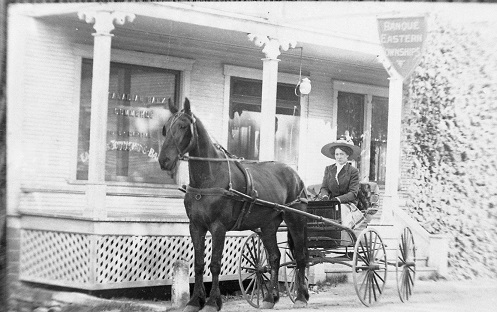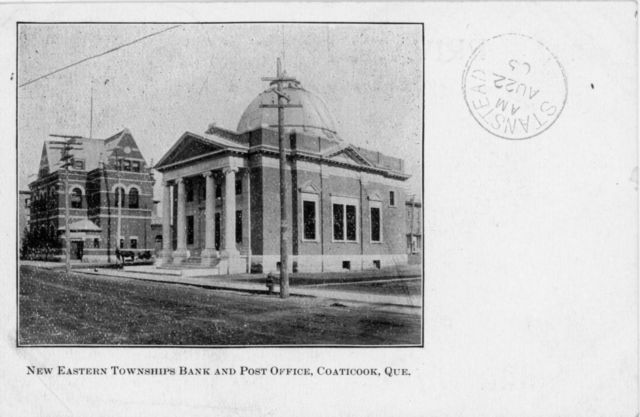

Share
The Eastern Townships Bank
June 19th, 2018
Walking down the main streets of any number of Townships’ towns – Coaticook, Rock Island, Danville, or Granby – passersby can find themselves taken in by the commanding neo-classical and second empire architectural styles of the buildings that once served as branches of the Eastern Townships Bank. Apart from the dramatic and almost intimidating nature of these buildings, the E.T. Bank played a meaningful role in the lives of the local population as it served farmers, artisans, and businessmen alike.
From the moment of its establishment in 1859, the Eastern Townships Bank was to be a bank supported by the people of the Townships and that served the people of the Townships. In fact, in 1863, 89% of the E.T. Bank’s capital was held by Townshippers. The presence of a regional bank and the access to loans meant that local businessmen and entrepreneurs were able to get their businesses off the ground. One small example of this was James H. Smith of Sutton, who received a loan from the Eastern Townships Bank so that he could become a dealer of carriages, harnesses, farming Implements, wagons, and cream separators. In addition to small businesses, the E.T. Bank invested in many of the large industries emerging in the Townships in the latter part of the 19th century, such as Jenckes Machine Shop in Coaticook, Royal Paper Mills in East Angus, and Paton Manufacturing Company in Sherbrooke.
The E.T. Bank had gone from a head office and two agencies in 1859 to 61 branches and 31 agencies in a span of 50 years. In addition to its more notable branches, the Eastern Townships Bank had a presence in a great many towns and villages throughout the region, including Roxton Falls, East Broughton, and Upton, which afforded smaller communities access to local banking services.
Beyond its practical involvement in the financial affairs of the region, the E.T. Bank displayed its Townships roots on its money and stock certificates; they bore farming and mining scenes as well as recognizable landscapes such as the iconic Lake Memphremagog steamer, the Lady of the Lake, and the Magog River Gorge in Sherbrooke.
The Eastern Townships Bank continued to grow into the early years of the 20th century but as shareholders from outside the region increased (by 1912, 64% of the Bank’s capital was held by those outside the Townships) and with increased competition from the major national banks, the directors of the Eastern Townships Bank elected to sell to the Canadian Bank of Commerce in 1912. Even though over 100 years have passed since its absorption into the Canadian Bank of Commerce, the Eastern Townships Bank continues to live on in the landscapes of the Eastern Townships. In the words of C.C. Colby: “[…] let us hope that the Eastern Townships Bank will never forget its years of youth amid the noble and beloved hills of the Eastern Townships!’

